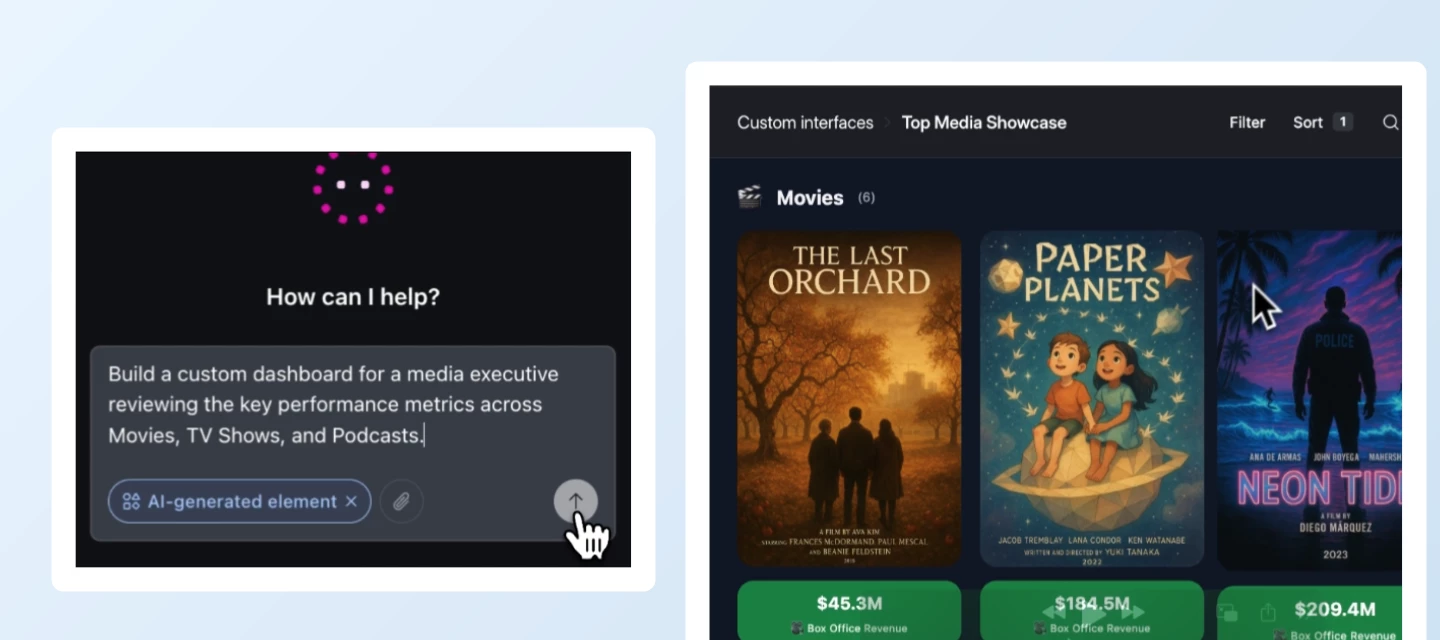Building on the recent launch of AI-generated interface elements, we’re excited to announce that custom interface elements can now pull in data from multiple tables. This was the community’s #1 request since launch! This capability applies to custom elements created via Omni (AI Labs) or created through the SDK (open beta for Teams, Business and Enterprise Scale plans.)
We’re also releasing two other highly requested upgrades:
- Version history for custom elements in Interface Designer: revert to using an older version of a custom element in an Interface page, which is particularly useful when Omni struggles to fix problems and you need to return to a known good state
- Revert and undo custom element changes in Omni chat: you can now revert to an older version of a custom element by clicking on a new “Revert” action next to any Omni message that made changes to the custom element, as well as undo’ing the last change by just asking Omni “Undo that” or similar
What are some examples of what you can build?
Build fully custom interface elements to visualize, edit, and interact with your data in ways that go beyond standard Airtable components. Rapidly generate custom elements using natural language through Omni, or develop your own with code through our SDK, supporting a wide range of technical needs and skill levels.
- Product portfolio management: create custom elements to plan different scenarios for how resources are allocated against objectives, allowing executives to make faster decisions about competing investments
- Capacity planning and resource allocation: create custom elements to ensure projects stay on track and teams aren’t overloaded
- Marketing dashboards: pull in data from multiple sources to understand campaign performance
How to get started with Omni (AI Labs)
AI-generated interface elements are available in AI Labs. Workspace admins can enable AI Labs from Account > Workspace Settings, while Enterprise admins can enable AI Labs from the Admin Panel. Once enabled, select “Tools” and then “Generate an Interface element” in Omni and describe the element you want to build. Reference the kinds of data (e.g. projects, tasks and teams) that you want to use in your element and Omni will help connect the element to the right tables.
How to get started with the Blocks SDK (Teams, Business and Enterprise Scale plans)
If you haven’t created custom elements with the Blocks SDK before, follow the tutorial here and your first custom element will support multi-table instantly.
If you have created a custom element and want to upgrade an existing project to use multi-table:
- Update your Blocks SDK with the terminal command:
npm install @airtable/blocks@interface-alpha - Update your Blocks CLI tool with the terminal command:
npm install -g @airtable/blocks-cli@latest - (If you’re using Cursor) Replace the file in your project found at
.cursor/rules/interface-extensions.mdcwith the contents of the file you can find here - Take a look at the updated documentation for reading and writing data from custom elements
Important details
- Generating custom interface elements with Omni does not consume credits
- Custom elements can also open Record Detail pages for all tables they’re connected to, and support a new “table” type of custom property that allows you to configure the tables they should connect to directly in Interface Designer
- This feature is in Labs/Beta and under active development—your feedback will directly shape improvements.
- Early access is available now for all AI Labs participants.
We can’t wait to see the unique interfaces you’ll create!





